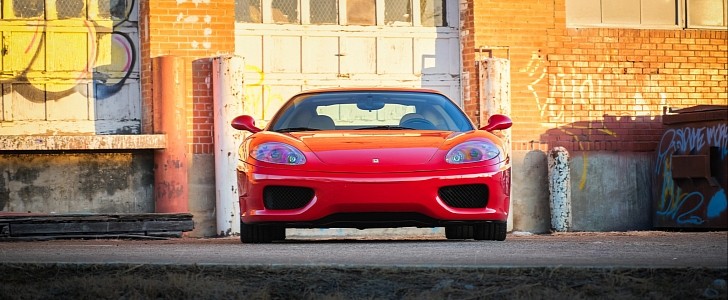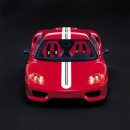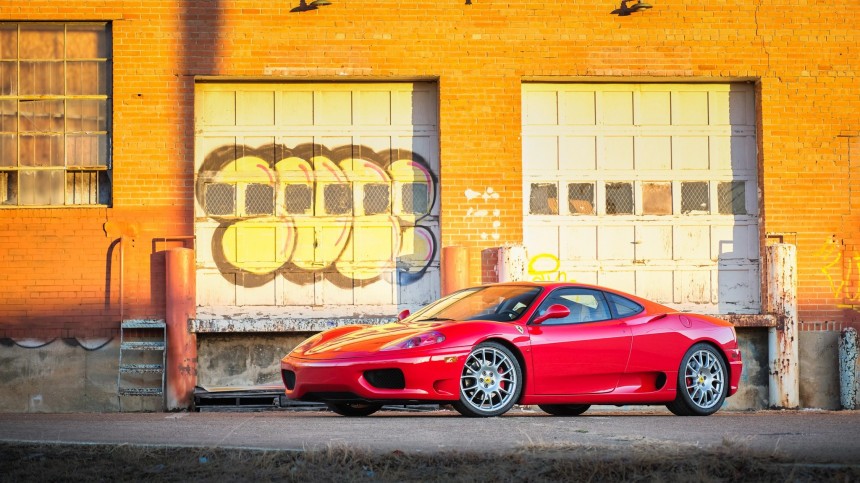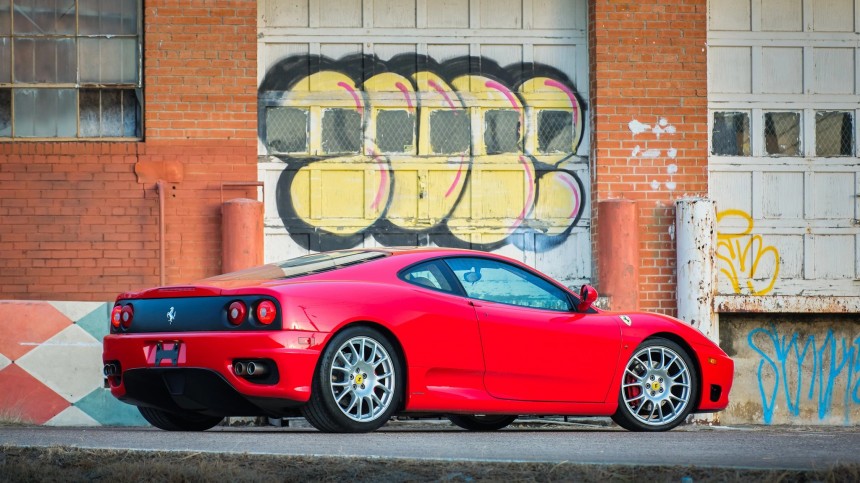The 355 was a tough act to follow, but Ferrari successfully reimagined its mid-engine sports car with the 360. Unveiled at the 1999 Geneva Motor Show, the Pininfarina-styled model was the last hurrah of the Dino V8.
Named after the first son of Enzo Ferrari, the Dino engine family started out with 2.0- and 2.4-liter V6 mills for street-legal applications. The V8 followed in the ‘70s. As opposed to 2.9 liters in the 308, the 360 is rated at 3,586 cubic centimeters. Similar to the amazing-sounding 355 before it, this fellow rocks double overhead cams that actuate five valves per cylinder.
Codenamed F131, the free-breathing motor retains the 85-millimeter bore of the F129 in the 355. The Prancing Horse of Maranello enlarged it by increasing the stroke from 77 to 79 millimeters, representing an overall gain of 90 cubic centimeters. Ferrari also made optimization to the intake and exhaust systems for better flow, lowered the compression ratio from 11.1:1 to 11.0:1, and decided on drive-by-wire throttle over a traditional cable.
Gifted with a flat-plane crankshaft, the last-ever Dino V8 is constructed from light alloy, while the connecting rods are made from titanium. In the 360 Modena, which is called this way after the birthplace of Enzo Ferrari, the F131 produces 400 ps (395 horsepower) at 8,500 revolutions per minute and 373 Nm (275 pound-feet) of torque at 4,750 revolutions per minute.
A six-speed manual transaxle came standard, complemented by a gated shifter. The F1 automated manual was optional. Cars fitted with the two-pedal transmission feature carbon-fiber paddles for extra visual pizzazz. The Italian automaker’s technical specs for the F1 include 150-millisecond upshifts, but F1-equipped cars are jerky in automatic mode and reverse.
Boasting a limited-slip differential as you’d expect of a high-end sports car, the 360 can hit 100 kilometers per hour (62 miles per hour) in 4.4 seconds, three tenths quicker than the 355. For the automated manual transmission, make that 4.2 seconds. Tipping the scales at 1,390 kilograms (3,064 pounds), the Modena tops 295 kilometers per hour (183 miles per hour).
Penned by Goran Popovic, the 360 doesn’t have pop-up headlights due to ever-tightening pedestrian safety regulations. Aluminum is predominantly used for the body panels, whereas the side skirts and bumpers are fiberglass. Capable of creating four times as much downforce as the 355, this sexy-looking sports car flaunts a flat underbody with oversized extractors.
Based on a lightweight aluminum space frame developed in collaboration with Alcoa, the 360 is both longer and wider than the 355 yet 40 percent stiffer. Aluminum is also used for the Sachs adaptive dampers that were designed to adapt in accordance with the steering angle, acceleration, braking, and speed of the vehicle. Normal and Sport damper settings, anti-roll bars fore and aft, and double wishbones with coil springs are featured as well.
Riding on 18-inch wheels inspired by the five-spoke design from the good ol’ days, the 360 was originally mounted with Pirelli tires. Cross-drilled and ventilated rotors are squeezed by four-piston calipers, and customary of a modern car, the traction control can be turned off for more sideways fun.
Dual fuel tanks are fitted on the sides of the powerplant, which drinks high-octane gasoline to the tune of 12 miles per gallon (19.6 liters per 100 kilometers) for the F1 transmission. The Environmental Protection Agency lists the manual with 11 mpg (21.3 liters per 100 kilometers) combined.
As far as the cockpit is concerned, the 360 marks a change for the better compared to previous V8-engined midships from the Italian automaker. The sporty-looking steering wheel frames a 10,000-rpm tachometer, whereas the speedometer indicates 340 kilometers per hour in metric or 220 miles per hour in the United States of America. In addition to the U.S., Liberia and Myanmar are the only other countries that still use the imperial system.
Ferrari presented the Spider at the 2000 Geneva Motor Show, and that year, the one-off Barchetta was commissioned as a wedding present for big kahuna Luca di Montezemolo. The final iteration of the series, dubbed Challenge Stradale, was presented at the 2003 Geneva Motor Show with 425 ps (419 horsepower) and 373 Nm (275 pound-feet) of torque on tap.
Discontinued in 2004 when the F430 was introduced with great pomp and circumstance with a brand-new V8 engine architecture shared with Maserati, the 360 sold 17,653 units in total. The berlinetta-bodied Modena numbers 8,800 units, the canvas-topped Spider comes in second place with 7,565 examples, and the Challenge Stradale numbers only 1,288 copies.
Codenamed F131, the free-breathing motor retains the 85-millimeter bore of the F129 in the 355. The Prancing Horse of Maranello enlarged it by increasing the stroke from 77 to 79 millimeters, representing an overall gain of 90 cubic centimeters. Ferrari also made optimization to the intake and exhaust systems for better flow, lowered the compression ratio from 11.1:1 to 11.0:1, and decided on drive-by-wire throttle over a traditional cable.
Gifted with a flat-plane crankshaft, the last-ever Dino V8 is constructed from light alloy, while the connecting rods are made from titanium. In the 360 Modena, which is called this way after the birthplace of Enzo Ferrari, the F131 produces 400 ps (395 horsepower) at 8,500 revolutions per minute and 373 Nm (275 pound-feet) of torque at 4,750 revolutions per minute.
A six-speed manual transaxle came standard, complemented by a gated shifter. The F1 automated manual was optional. Cars fitted with the two-pedal transmission feature carbon-fiber paddles for extra visual pizzazz. The Italian automaker’s technical specs for the F1 include 150-millisecond upshifts, but F1-equipped cars are jerky in automatic mode and reverse.
Penned by Goran Popovic, the 360 doesn’t have pop-up headlights due to ever-tightening pedestrian safety regulations. Aluminum is predominantly used for the body panels, whereas the side skirts and bumpers are fiberglass. Capable of creating four times as much downforce as the 355, this sexy-looking sports car flaunts a flat underbody with oversized extractors.
Based on a lightweight aluminum space frame developed in collaboration with Alcoa, the 360 is both longer and wider than the 355 yet 40 percent stiffer. Aluminum is also used for the Sachs adaptive dampers that were designed to adapt in accordance with the steering angle, acceleration, braking, and speed of the vehicle. Normal and Sport damper settings, anti-roll bars fore and aft, and double wishbones with coil springs are featured as well.
Riding on 18-inch wheels inspired by the five-spoke design from the good ol’ days, the 360 was originally mounted with Pirelli tires. Cross-drilled and ventilated rotors are squeezed by four-piston calipers, and customary of a modern car, the traction control can be turned off for more sideways fun.
As far as the cockpit is concerned, the 360 marks a change for the better compared to previous V8-engined midships from the Italian automaker. The sporty-looking steering wheel frames a 10,000-rpm tachometer, whereas the speedometer indicates 340 kilometers per hour in metric or 220 miles per hour in the United States of America. In addition to the U.S., Liberia and Myanmar are the only other countries that still use the imperial system.
Ferrari presented the Spider at the 2000 Geneva Motor Show, and that year, the one-off Barchetta was commissioned as a wedding present for big kahuna Luca di Montezemolo. The final iteration of the series, dubbed Challenge Stradale, was presented at the 2003 Geneva Motor Show with 425 ps (419 horsepower) and 373 Nm (275 pound-feet) of torque on tap.
Discontinued in 2004 when the F430 was introduced with great pomp and circumstance with a brand-new V8 engine architecture shared with Maserati, the 360 sold 17,653 units in total. The berlinetta-bodied Modena numbers 8,800 units, the canvas-topped Spider comes in second place with 7,565 examples, and the Challenge Stradale numbers only 1,288 copies.










































